SLVS897C January 2009 – December 2015 TPS62590
PRODUCTION DATA.
- 1 Features
- 2 Applications
- 3 Description
- 4 Revision History
- 5 Pin Configuration and Functions
- 6 Specifications
- 7 Detailed Description
- 8 Application and Implementation
- 9 Power Supply Recommendations
- 10Layout
- 11Device and Documentation Support
- 12Mechanical, Packaging, and Orderable Information
Package Options
Mechanical Data (Package|Pins)
- DRV|6
Thermal pad, mechanical data (Package|Pins)
- DRV|6
Orderable Information
8 Application and Implementation
NOTE
Information in the following applications sections is not part of the TI component specification, and TI does not warrant its accuracy or completeness. TI’s customers are responsible for determining suitability of components for their purposes. Customers should validate and test their design implementation to confirm system functionality.
8.1 Application Information
The TPS62590 device is a high-efficiency synchronous step-down DC–DC converter featuring power-save mode or 2.25-MHz fixed frequency operation.
8.2 Typical Application
 Figure 6. TPS62590DRV Adjustable 1.8 V
Figure 6. TPS62590DRV Adjustable 1.8 V
8.2.1 Design Requirements
The device operates over an input voltage range from 2.5 V to 5.5 V. The output voltage is adjustable using an external feedback divider.
8.2.2 Detailed Design Procedure
8.2.2.1 Output Voltage Setting
The output voltage can be calculated by Equation 2 with the internal reference voltage VREF = 0.6 V typically.

To minimize the current through the feedback divider network, R2 should be 180 kΩ or 360 kΩ. The sum of R1 and R2 should not exceed ~1 MΩ, to keep the network robust against noise. An external feed forward capacitor C1 is required for optimum load transient response. The value of C1 should be in the range between 22 pF and 33 pF.
Route the FB line away from noise sources, such as the inductor or the SW line.
8.2.2.2 Output Filter Design (Inductor and Output Capacitor)
The TPS62590 is designed to operate with inductors in the range of 1.5 μH to 4.7 μH and with output capacitors in the range of 4.7 μF to 22 μF. The part is optimized for operation with a 2.2-μH inductor and 10-μF output capacitor. Larger or smaller inductor values can be used to optimize the performance of the device for specific operation conditions. For stable operation, the L and C values of the output filter may not fall below 1-μH effective inductance and 3.5-μF effective capacitance.
8.2.2.2.1 Inductor Selection
The inductor value has a direct effect on the ripple current. The selected inductor has to be rated for its DC resistance and saturation current. The inductor ripple current (ΔIL) decreases with higher inductance and increases with higher VIN or VOUT.
The inductor selection has also impact on the output voltage ripple in PFM mode. Higher inductor values will lead to lower output voltage ripple and higher PFM frequency, lower inductor values will lead to a higher output voltage ripple but lower PFM frequency.
Equation 3 calculates the maximum inductor current under static load conditions. The saturation current of the inductor should be rated higher than the maximum inductor current as calculated with Equation 4. This is recommended because during heavy load transient the inductor current will rise above the calculated value.


where
- f = Switching frequency (2.25 MHz typical)
- L = Inductor value
- ΔIL = Peak-to-peak inductor ripple current
- ILmax = Maximum inductor current
A more conservative approach is to select the inductor current rating just for the maximum switch current of the corresponding converter.
Accepting larger values of ripple current allows the use of low inductance values, but results in higher output voltage ripple, greater core losses, and lower output current capability.
The total losses of the coil have a strong impact on the efficiency of the DC–DC conversion and consist of both the losses in the DC resistance (R(DC)) and the following frequency-dependent components:
- The losses in the core material (magnetic hysteresis loss, especially at high switching frequencies)
- Additional losses in the conductor from the skin effect (current displacement at high frequencies)
- Magnetic field losses of the neighboring windings (proximity effect)
- Radiation losses
Table 1. List of Inductors
| DIMENSIONS [mm3] | INDUCTOR TYPE | SUPPLIER |
|---|---|---|
| 3 × 3 × 1.5 | LPS3015 | Coilcraft |
| 3 × 3 × 1.5 | LQH3NPN2R2NM0 | MURATA |
| 3.2 × 2.6 × 1.2 | MIPSA3226D2R2 | FDK |
8.2.2.2.2 Output Capacitor Selection
The advanced fast-response voltage mode control scheme of the TPS62590 allows the use of tiny ceramic capacitors. Ceramic capacitors with low ESR values have the lowest output voltage ripple and are recommended. The output capacitor requires either an X7R or X5R dielectric. Y5V and Z5U dielectric capacitors, aside from their wide variation in capacitance over temperature, become resistive at high frequencies.
At nominal load current, the device operates in PWM mode and the RMS ripple current is calculated by Equation 5:

At nominal load current, the device operates in PWM mode and the overall output voltage ripple is the sum of the voltage spike caused by the output capacitor ESR plus the voltage ripple caused by charging and discharging the output capacitor shown in Equation 6:

At light load currents the converter operates in power save mode and the output voltage ripple is dependent on the output capacitor and inductor value. Larger output capacitor and inductor values minimize the voltage ripple in PFM mode and tighten DC output accuracy in PFM mode.
8.2.2.2.3 Input Capacitor Selection
The buck converter has a natural pulsating input current; therefore, a low ESR input capacitor is required for best input voltage filtering and minimizing the interference with other circuits caused by high input voltage spikes. For most applications, a 10-μF ceramic capacitor is recommended. The input capacitor can be increased without any limit for better input voltage filtering.
Take care when using only small ceramic input capacitors. When a ceramic capacitor is used at the input and the power is being supplied through long wires, such as from a wall adapter, a load step at the output or VIN step on the input can induce ringing at the VIN pin. The ringing can couple to the output and be mistaken as loop instability or could even damage the part by exceeding the maximum ratings.
Table 2. List of Capacitor
| CAPACITANCE | TYPE | SIZE | SUPPLIER |
|---|---|---|---|
| 10 μF | GRM188R60J106M69D | 0603 1.6 × 0.8 × 0.8mm3 | Murata |
Table 3 shows the list of components for the Application Curves.
Table 3. List of Components
| COMPONENT REFERENCE | PART NUMBER | MANUFACTURER | VALUE |
|---|---|---|---|
| CIN | GRM188R60J106M | Murata | 10 μF, 6.3-V. X5R Ceramic |
| COUT | GRM188R60J106M | Murata | 10 μF, 6.3-V. X5R Ceramic |
| C1 | Murata | 22-pF, COG Ceramic | |
| L1 | LPS3015 | Coilcraft | 2.2 μH, 110 mΩ |
| R1, R2 | Values depending on the programmed output voltage | ||
8.2.3 Application Curves
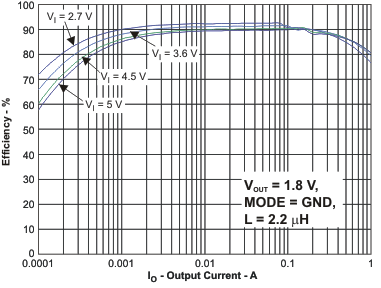 Figure 7. Efficiency vs Output Current
Figure 7. Efficiency vs Output Current
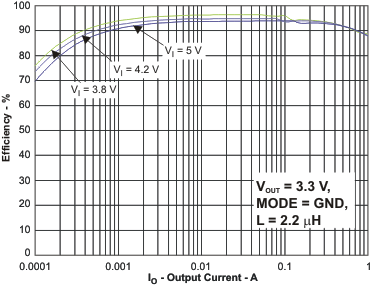 Figure 9. Efficiency vs Output Current
Figure 9. Efficiency vs Output Current
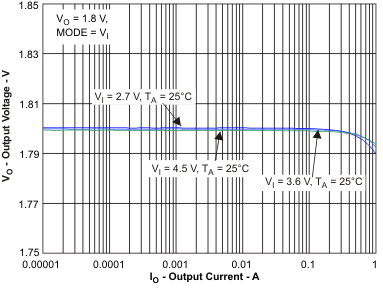 Figure 11. Output Voltage vs Output Current
Figure 11. Output Voltage vs Output Current
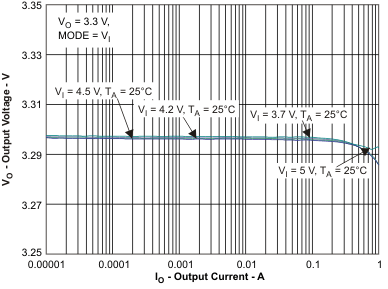 Figure 13. Output Voltage vs Output Current
Figure 13. Output Voltage vs Output Current
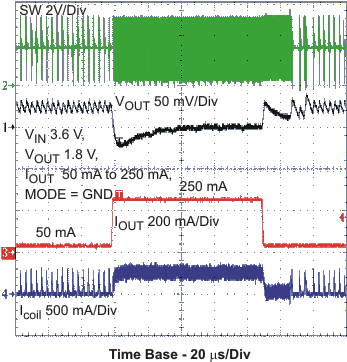 Figure 15. PFM Load Transient
Figure 15. PFM Load Transient
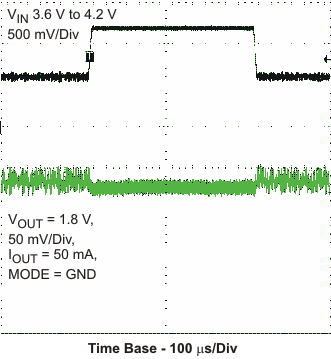 Figure 17. PFM Line Transient
Figure 17. PFM Line Transient
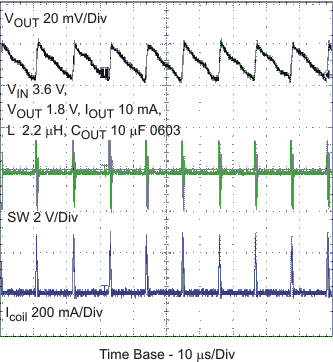 Figure 19. Typical Operation – PFM Mode
Figure 19. Typical Operation – PFM Mode
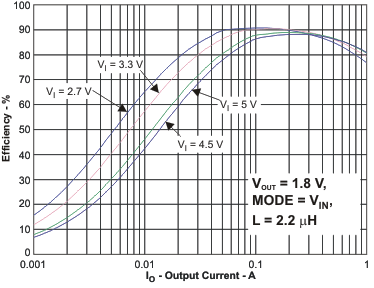 Figure 8. Efficiency vs Output Current
Figure 8. Efficiency vs Output Current
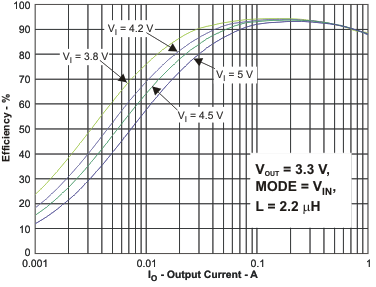 Figure 10. Efficiency vs Output Current
Figure 10. Efficiency vs Output Current
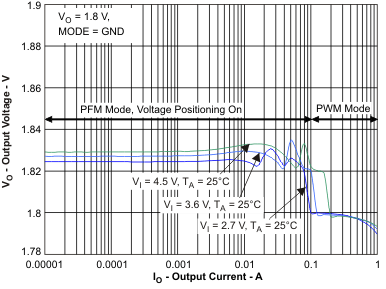 Figure 12. Output Voltage vs Output Current
Figure 12. Output Voltage vs Output Current
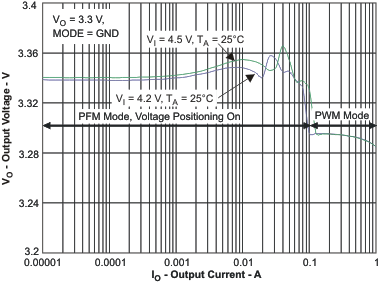 Figure 14. Output Voltage vs Output Current
Figure 14. Output Voltage vs Output Current
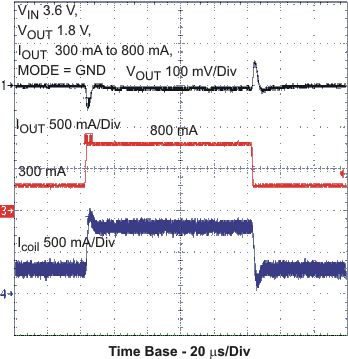 Figure 16. PWM Load Transient
Figure 16. PWM Load Transient
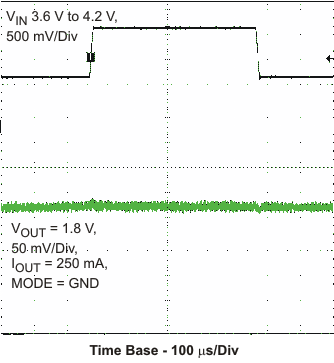 Figure 18. PWM Line Transient
Figure 18. PWM Line Transient
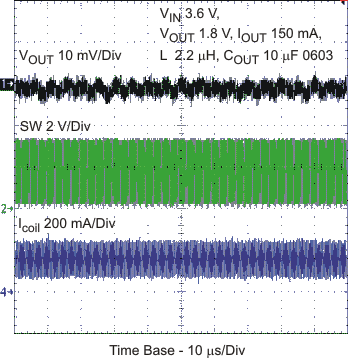 Figure 20. Typical Operation – PWM Mode
Figure 20. Typical Operation – PWM Mode
8.3 System Example
 Figure 21. TPS62590DRV Adjustable 3.3 V
Figure 21. TPS62590DRV Adjustable 3.3 V